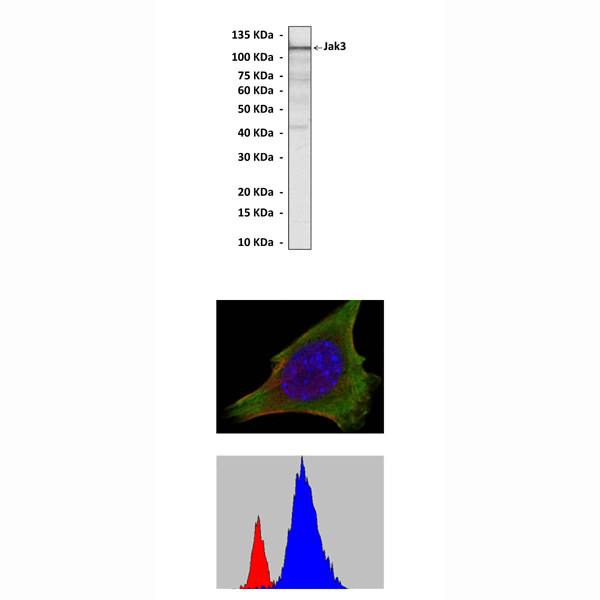Anti-Jak3: Mouse Jak3 Antibody |
 |
BACKGROUND JAKs (or Janus kinases) are a family of tyrosine kinases that associated with receptors of interferons and type I cytokines. Upon receptor activation JAKs phosphorylate and thereby activate the transcription factors known as STATs, and initiate the JAK-STAT signaling pathway. Before activation, STAT proteins are cytosolic proteins; after activation, however, they are translocated to the nucleus where they function as transcription factors. Four JAK family members have been identified (JAK1, JAK2, JAK3 and Tyk2), which share a similar protein domain structure: a kinase domain, a regulatory pseudo-kinase domain, a SH2 domain and a FERM domain. The FERM domain of JAK family members mediates the association of JAK with other enzymes and cytokine receptors. Of these, Jak1 and -2 and Tyk2 are ubiquitously expressed, while Jak3 is found predominantly in immune and hematopoietic tissues. The JAK Tyk2 associates with the IFN-I, IL-6, 10, 12, and 23 cytokine receptor families. JAK1 mediates signals from IFN-alpha, beta, gamma and IL-2, 6 receptors. JAK2 transduces signals from the single chain and IL-3 cytokine receptor families, and from the IFN-gamma receptors. JAK3 associates with the IL-2 receptor gamma-chain.1
Jak3 is a cytoplasmic tyrosine kinase that associates with the common chain of the interleukin-2 (IL-2) receptor and is involved in the function of the receptors for IL-2, IL-4, IL-7, IL-9, and IL-15. Jak3 Phosphorylates STAT6, IRS1, IRS2 and PI3K. Mice deficient in Jak3 have few T and B cells, and no natural killer cells. The myeloid lineages in these mice are also affected by the loss of Jak3.2 Mutations in Jak3 gene are associated with autosomal SCID (severe combined immunodeficiency disease).3 Many of the lymphoid defects of Jak3-deficient mice can be accounted for by the lack of IL-7R and IL-2R signaling; however, other cytokine systems must also be involved in maintaining peripheral lymphocyte homeostasis. On the other hand, due to its central role in lymphocyte activation, proliferation and homeostasis, targeting the JAK/signal transducer and activator of transcription (STAT) pathway may provide the required efficacy, without the toxicities associated with current therapies. Several studies conducted in rodents have validated the proof-of-concept, with a variety of JAK3 inhibitors demonstrating efficacy for immune suppression.4
REFERENCES
1. Verma, A. et al: Cancer Metastas. Rev. 22:423-34, 2004
2. Grossman, W.J. et al: Blood 94:932-9, 1999
3. Pesu, M. et al: Immunol. Rev. 203:127-142, 2005
4. Borie, D.C. et al: Curr Opin Investig Drugs 4:1297-303, 2003
2. Grossman, W.J. et al: Blood 94:932-9, 1999
3. Pesu, M. et al: Immunol. Rev. 203:127-142, 2005
4. Borie, D.C. et al: Curr Opin Investig Drugs 4:1297-303, 2003
Products are for research use only. They are not intended for human, animal, or diagnostic applications.
Параметры
Cat.No.: | CP10142 |
Antigen: | Purified recombinant human Jak3 fragments expressed in E. coli. |
Isotype: | Mouse IgG1 |
Species & predicted species cross- reactivity ( ): | Human, Mouse |
Applications & Suggested starting dilutions:* | WB 1:1000 - 1:10000 IP n/d IHC n/d ICC 1:250 - 1:500 FACS 1:200 - 1:400 |
Predicted Molecular Weight of protein: | 115 kDa |
Specificity/Sensitivity: | Detects endogenous Jak3 proteins without cross-reactivity with other family members. |
Storage: | Store at -20°C, 4°C for frequent use. Avoid repeated freeze-thaw cycles. |
*Optimal working dilutions must be determined by end user.
Документы
Информация представлена исключительно в ознакомительных целях и ни при каких условиях не является публичной офертой








